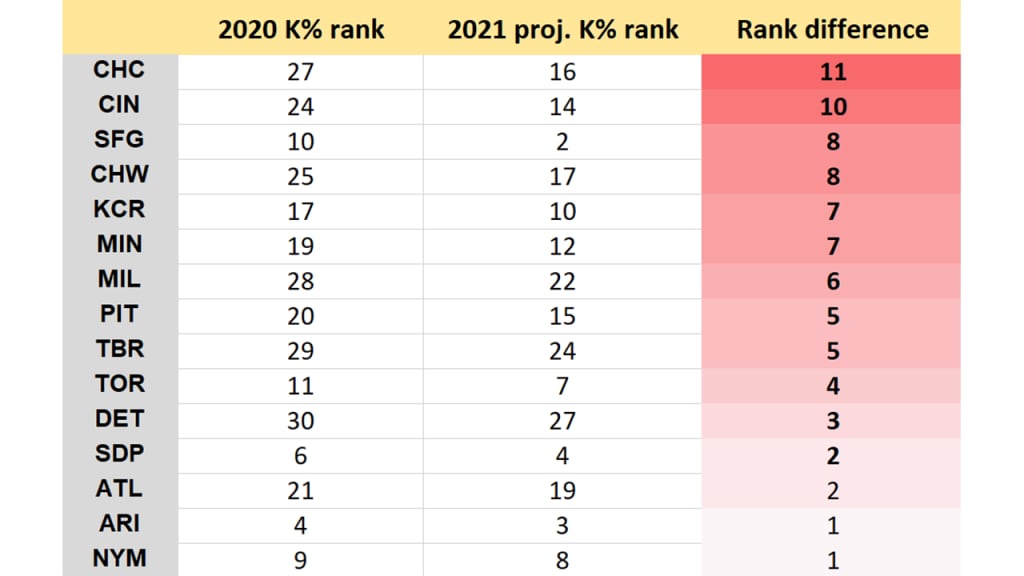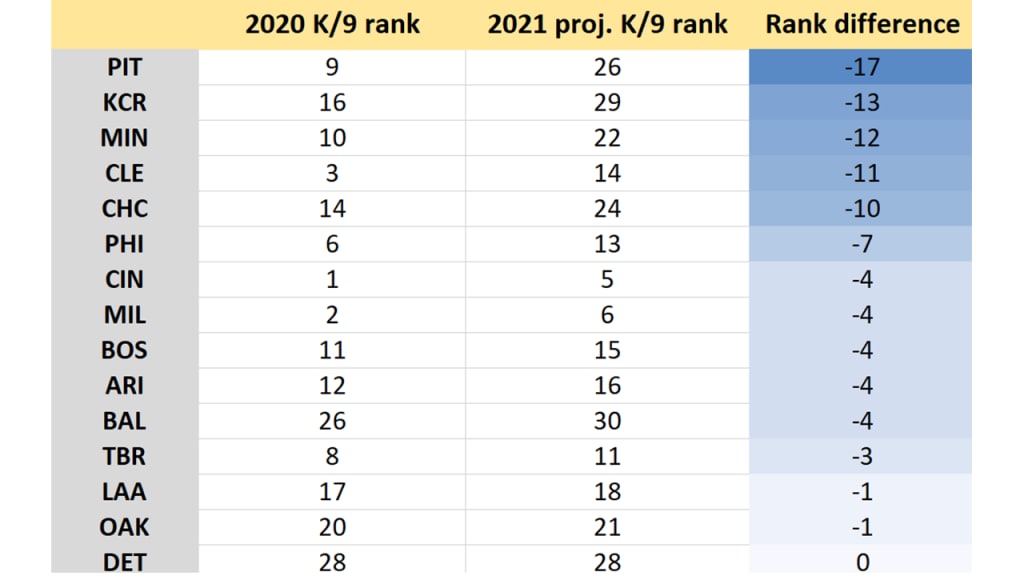"Ideally," Cubs president of baseball operations Jed Hoyer told The Athletic in December, "we need fewer strikeouts, some better decision-making, better contact rates."
Fewer strikeouts. Sounds good. In theory. If you're looking for more balls in play, the 2021 Cubs might be your team ... for better, or, perhaps, worse.
Let's explain. Chicago's offense had the fourth-highest strikeout rate in baseball in 2020, which became the focal point of a dreadfully underwhelming lineup. While Hoyer was clearly talking about his hitters, he had a pretty effective strikeout pitching staff (ninth-highest strikeout rate), too. Cubs games featured lots of strikeouts. No ballpark, for example, saw more called strikes and swing-and-misses than the 2,926 that happened at Wrigley Field.
So the Cubs made some moves. Gone is Kyle Schwarber, and his 28% career strikeout rate. Gone are bit players Billy Hamilton, José Martínez, Steven Souza and Jason Kipnis, who combined for a 34% strikeout rate in limited time. But also gone is starter Yu Darvish, who had the seventh-most strikeouts in the Majors last year, and Tyler Chatwood, who had a 29% strikeout rate, and really any starter who throws hard.
The 2021 Cubs offense should make more contact. The 2021 Cubs pitching should also allow more contact. If you want action, there's going to be action at Wrigley. But to what end? Let's figure it out.
1. No lineup is projected to improve their strikeout ranking as much
So, as we said above: The Cubs had the fourth-worst strikeout rate in 2020, or 27th-best, if that's how you prefer to look at it. They stepped to the plate 2,214 times, and they struck out 568 times. That's too many. It's bad. But what about 2021? We went on over to FanGraphs and looked at their 2021 projections, which combine playing time expectations and projected 2021 stats. That accounts for new players on new teams in new situations, and also rolls in projections based on more than just 2020.
Put all that together, and you get this. Last year, the Cubs were 27th in strikeout rate. This year, they're projected to be 16th. That's a jump of 11 spots. That's the largest improvement in baseball, and even if "middle of the pack" isn't that impressive, it would still be a considerable step up from last year.

Part of that is the departure of the strikeout-heavy names we noted above. Part of it is that while newcomer Joc Pederson has some swing-and-miss in his game, it's less than you think, and certainly less than Schwarber. (He whiffed 28.3% of the time in his first two years in 2015-16, but had cut that down to 20.5% in 2018-19.)
Part of it is the expectation that Nico Hoerner and his above-average contact rate can take the bulk of time at second base. ‘"As a group and personally, we got defensive [at the plate] at times as an offense [last season], and that’s not who I am,’’ he told the Sun-Times last week. ‘‘It’s not who we are as a group.’’
It may not be who they wanted to be, but it is who they were. In 2020, Cubs hitters had the third-highest take rate on balls in the zone or on the edges, and the second-lowest first-pitch swing rate. No team had a higher rate of plate appearances ending on two strikes. There's value, obviously, in being selective, in not going after bad pitches. It's also pretty difficult to strike out when you don't have two strikes. What did Hoyer say at the beginning? "Some better decision-making."
So there's that, but in addition, there's a reasonable expectation that with a more "regular" 2021, some of the team's stars can get back to normal -- Kris Bryant, Willson Contreras, Javier Báez and Jason Heyward all had 2020 strikeout rates higher than they'd had in the previous four seasons.
Now, "most improved" is a bit of a trick question, obviously; the 2020 Astros had the lowest strikeout rate in the Majors, and they're projected to have the lowest strikeout rate again in 2021. You can't really improve upon "being the best." In order to improve, you need to have been doing something less than ideally in the first place. The 2020 Cubs were. The 2021 Cubs might be better in this department.
2. Few pitching staffs are projected to decline their strikeout ranking as much
More balls in play for an offense would generally be considered a good thing. What about for a pitching staff? Not ... so much. It was only a few days ago, after all, that Cincinnati pitching coach Derek Johnson gave away the entire game.
“I like guys that can make hitters swing and miss,” Johnson said. “If you look at ground balls, yeah, if they’re weakly hit, they’re out. But ground balls are hits a lot of times. Then you couple that with a walk, couple that with a homer, and all of a sudden, we’re looking at three or four [runs]. Again, swings and misses don’t lie. I’d much rather have a swing and miss than a ground ball.”
Right. There's just about nothing that correlates better to pitching success than strikeouts, and it's not hard to see the relationship. The top five strikeout teams in 2019-20 were the Astros, Reds, Rays, Indians and Dodgers, all teams with top-end pitching. The bottom five clubs were the Rockies, Mariners, Orioles, Royals and Tigers. Needless to say, you don't want to be those teams. Nothing is driving the eternal increase in whiffs across baseball more than the fact that pitchers are better at generating them, and the importance of them has never been clearer.
The 2020 Cubs were pretty good at missing bats. The 2021 Cubs? Potentially less so, even without the low-strikeout Jon Lester, off with Schwarber to Washington. (We're using K/9 rather than the superior K% here just due to the availability of stats in projections.)

The Cubs' pitching, particularly without Darvish, isn't projected to miss a ton of bats in 2021. That's mostly about the rotation, because in the bullpen, Craig Kimbrel looked spectacular last September, for example, and Jason Adam, Brad Wieck, Rowan Wick and Ryan Tepera have their bat-missing moments, too. But the projected rotation for the Cubs right now, as FanGraphs has it, looks like this:
- Kyle Hendricks
- Zach Davies
- Alec Mills
- Jake Arrieta
- Trevor Williams
- Adbert Alzolay
- Shelby Miller
There's talent in there, obviously. Hendricks has long been one of the best starters in baseball, despite not generating strikeouts. But that group combined to whiff just 7.6 per nine last year, or 20.6% of batters. That 7.6 per nine would have been the lowest of any non-Coors rotation in baseball. Put another way, the average strikeout rate in baseball last year was 23.4%, and only three Cubs starters reached it: Darvish (traded), Chatwood (left as free agent) and Alzolay (21 1/3 innings).
Arrieta was once a Chicago ace; now he's trying his best to battle declining velocity and strikeout rates long enough to stay in the Majors. Mills tops out around 90 mph. Davies barely ever reaches 90 mph. Williams averaged only 91.5 mph last year. While Alzolay and prospect Brailyn Marquez throw hard, this Cubs rotation really won't, and that's actually worth taking a moment on, because ...
3) The Cubs might have baseball's softest-tossing rotation
... right. Actually, forget 2021, because they just did have baseball's softest-tossing rotation. In 2020, their starters averaged 90.4 mph on their fastballs, last in baseball. But now they're without their hardest thrower, Darvish (95.6 mph). They're without their third-hardest thrower, Chatwood (94.2 mph). They're without their fifth-hardest thrower, Colin Rea (92.5 mph), and sixth-hardest thrower, José Quintana (91.3 mph). It's true that Lester didn't throw hard (89.1 mph) and he's gone, but Davies averages only 88.4 mph.
So back to the FanGraphs depth charts we go, taking 2020 fastball velocities and weighting them by projected innings, which gives us a projected Cubs rotation velocity in 2021 ... of a nearly identical 90.5 mph. Dating back to 2008, when reliable pitch tracking first came online, there have only been 11 rotations to average 90 mph or below on their fastballs. Most of them had an outlier situation, like knuckleballer R.A. Dickey or 46-year-old Jamie Moyer.
Obviously, it may not play out like this. If Arrieta, for example, can't regain his lost velocity, then maybe he's not pitching and Marquez or Alzolay get more innings. There's so much we can't predict. But we do know that last year's Cubs rotation had the lowest fastball velocity in baseball, and they've shed their best and hardest-throwing pitcher in Darvish.
That's going to lead to more balls in play, which is generally a bad thing for any pitching staff. In Chicago's case, they do have one saving grace, and that's ...
4) The defense should be quite good
... as it has been for some time. For the first time, "team" Gold Gloves were issued in 2020, and the Cubs took home the National League Award. That's a good thing, because they're going to have a lot of work to do. Heyward, for his part, is excited about this.
"I love that, to be honest," he told MLB.com in February. "There's times where the game can get boring in right field. I think our guys pitch to contact, but they pitch to smart contact. These guys pitch to get outs, not pitch to punch people out and strike out."
Which, if not necessarily desirable, is at least accurate. Last year, Cubs infielders allowed the lowest average against on ground balls, which is probably a little about some soft contact induced by the pitchers and a lot about the skill of the fielders involved.
Lowest average against on grounders, 2020
.200 -- Cubs
.202 -- Cardinals
.205 -- Giants
.210 -- Dodgers
.215 -- White Sox
Pederson ought to be an upgrade over Schwarber in left. Jake Marisnick, recently signed to come off the bench, is one of the better defensive outfielders in the game, and Heyward is still solid, if not quite as elite as he once was. (Ian Happ plays more for his bat than his glove.) The 2021 Cubs defense will probably be pretty good, especially if Hoerner wins the job at second base.
If you want more balls in play, as everyone seems to, there's an endless amount of ideas and suggestions and rule changes to get the sport there. We may not need to look any further than the 2021 Cubs, though. They'll be improved at making contact on offense, and almost certain to miss fewer bats on the mound. There will be action in Wrigley. For better, again, or for worse.
